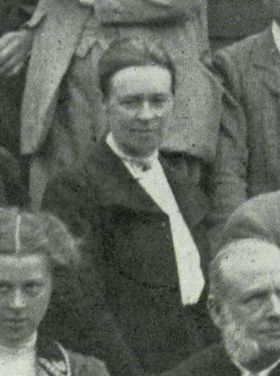Gulielma Lister facts for kids
Quick facts for kids
Gulielma Lister
|
|
|---|---|

Gulielma Lister, 1905
|
|
| Born | 28 October 1860 Leytonstone, Essex, UK
|
| Died | 18 May 1949 (aged 88) |
| Known for | Authority on Mycetozoa |
| Scientific career | |
| Fields | Mycology |
| Institutions | British Museum (NH) |
| Author abbrev. (botany) | G.Lister |
Gulielma Lister (born October 28, 1860 – died May 18, 1949) was a British scientist. She was a botanist, meaning she studied plants. She was also a mycologist, which means she studied fungi. Gulielma Lister was known as a world expert on Mycetozoa, which are tiny, jelly-like organisms that can move around.
Contents
Life Story
Gulielma Lister was born on October 28, 1860, in Leytonstone, England. She was one of seven children in her family. Her family was part of the Quaker community, a religious group known for its peaceful beliefs. Her grandfather, J.J. Lister, and her uncle, Lord Lister, were also well-known.
Gulielma was mostly taught at home. She spent one year at Bedford College for Women, where she learned a lot about how plants are structured and how to classify them. Her mother was an artist, and this likely influenced Gulielma's own artistic skills.
She lived most of her life in Leytonstone. Her family also had a summer house in Lyme Regis, where she did much of her outdoor research. Gulielma Lister passed away in the same house where she was born on May 18, 1949, after having a stroke. Her ashes were scattered at the Quaker Meeting House in Bush Road.
Studying Nature: Plants and Fungi
Gulielma Lister became interested in nature because of her father, Arthur Lister. Even though he was a wine merchant, he spent a lot of time studying Mycetozoa (slime moulds). Gulielma helped him with his research, working as his assistant in the field and in the lab.
She helped her father write his book, Monograph of Mycetozoa, which came out in 1894. After his death, Gulielma continued his work. She updated and expanded the book with two new editions in 1911 and 1925. These later versions included her own beautiful watercolor drawings of slime moulds.
Around this time, Gulielma also started working at the British Museum (Natural History) with her father. She never had an official job there, but she was a respected researcher. She also studied and organized plant collections at other famous places, like Kew Gardens in London, the Natural History Museum in Paris, and the University of Strasbourg.
Important Roles in Science
Gulielma Lister was very active in scientific groups. She joined the British Mycological Society in 1903 and was one of its first 100 members. She was even chosen to be the president of the society twice, in 1912 and 1932. In 1924, she became an honorary member because of her hard work.
She also led the Essex Field Club as its president from 1916 to 1919, becoming the first woman to hold that position. After that, she was a permanent vice-president. In December 1904, she was one of the first women to become a fellow of the Linnean Society of London, a very old and respected scientific group. She also served on its council and was a vice-president there. From 1917 until she died, Gulielma was a trustee for the Botanical Research Fund and chaired the School Nature Study Union for many years.
Global Connections and Other Interests
Gulielma Lister communicated with other mycologists from all over the world. She even exchanged letters with the Emperor of Japan, who sent her special enamel vases to thank her for her help with his studies. To keep up with new research, Gulielma even learned Polish so she could read the work of Jósef Tomasz Rostafinski, a scientist who studied Myxogastria (a type of slime mould) in Europe.
She also helped with the Royal Irish Academy's Clare Island Survey, a big project to study the plants and animals of an island in Ireland. Robert Lloyd Praeger, another scientist, said that Gulielma helped a lot with the study of slime moulds in Ireland.
Besides slime moulds, Gulielma was also interested in other animals, like birds, and in coniferous trees (trees that have cones, like pine trees). She drew the pictures for books about these topics, including Handbook of Coniferae and Illustrated Monograph of the British Hieracia.
Today, Gulielma Lister's collections of plants and fungi can be found in the Natural History Museum in London, the Stratford Museum, and Kew Gardens. She left 74 research notebooks to the British Mycological Society. These notebooks are now at the Natural History Museum and show all the amazing work she and her father did.
See also
 In Spanish: Gulielma Lister para niños
In Spanish: Gulielma Lister para niños

